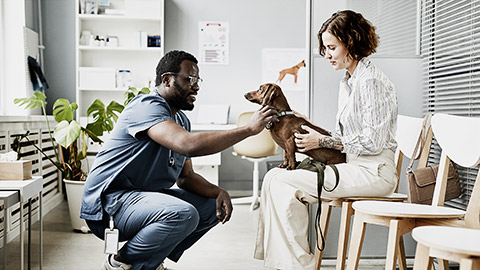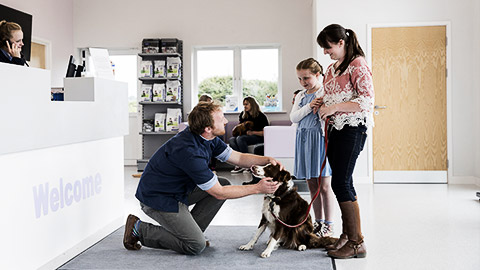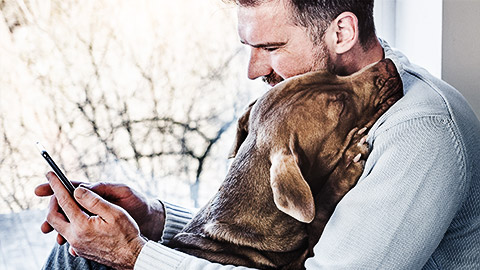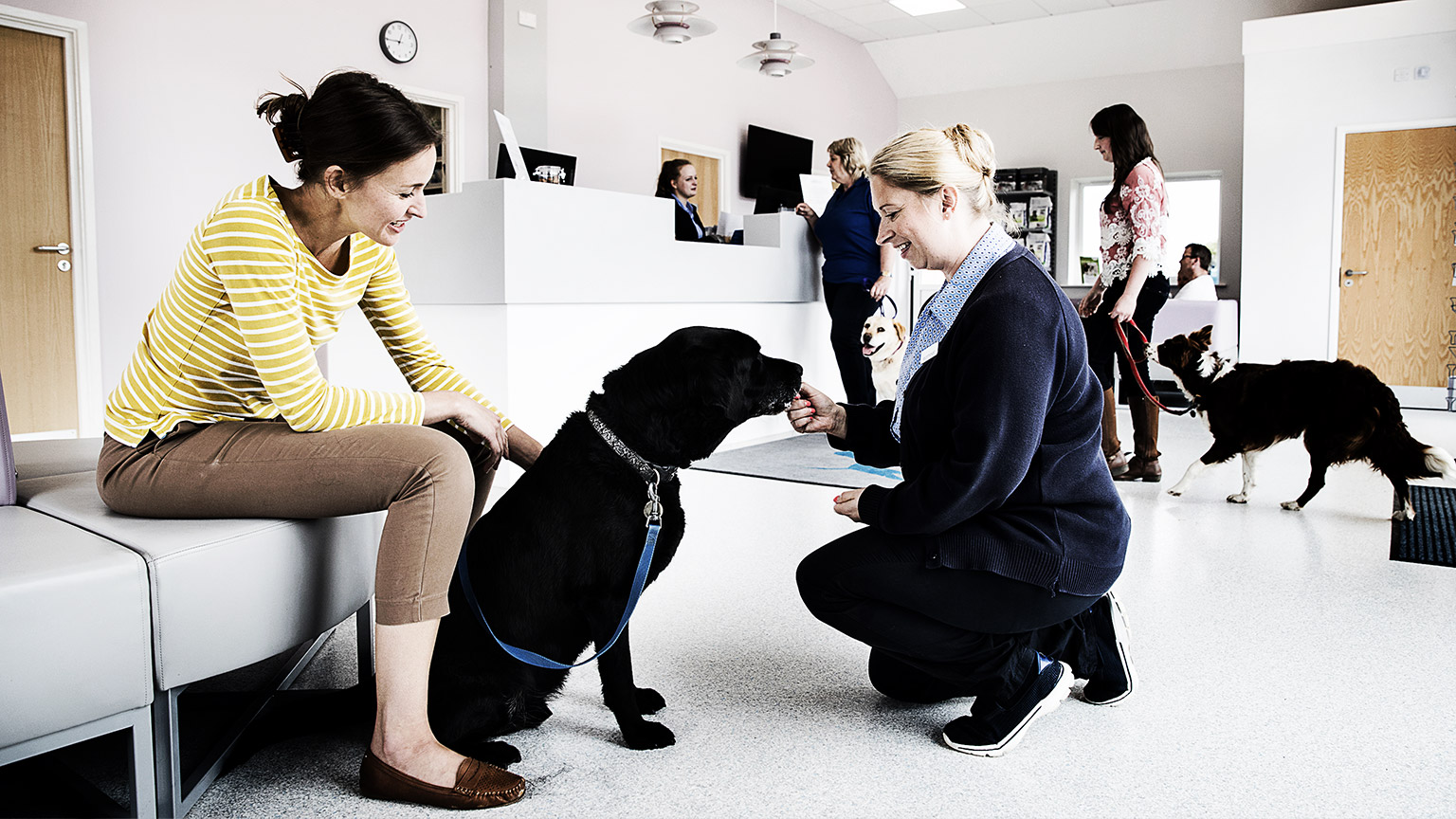Financial and administrative procedures relative to receptionist role in an animal care facility
One of the many questions that customers/clients will ask when they make an enquiry, or an appointment is “How much will that cost?” So, you will have to answer many questions within your organisation. It is an important fact to remember that all people that shop around are potential customers/clients.
It is important that you remember that when a customer s/client comes to your business either for the first time or hundredth time you are the first person that they will meet. What and how you speak to them and the information you provide to them will be a deciding whether to choose your facility or stay with your facility.
Who are people that shop around?
As you may be aware there are a number of people that will call up a business and ask for the price of a service, these people are shopping around to find the best price, but also, they will be listening to see who has the best services.
Even though these people are strangers, and you may never have spoken to them before you will know two important facts about them, this being:
- They have a pet
- They are going to spend money in your business for services provided
It is therefore vitally important that you have the ability to be able to sell your facility and, show them that your facility has the ability and skill to provide a service to their pets.
Communicating service value

You may not know or understand but giving price information to customers/clients is much more involved than what it looks or more than just knowing the cost of a groom or even a long stay in a kennel or cattery.
You need to know general information about the services your facility offers as well as what animals can access these services and the costs associated with the services. This information will vary depending on the facility you work at but could include information on the following:
- Preventative medications such as flea, worming and tick medications
- Grooming requirements for different species and breeds
- General information regarding products the facility sells including brushes, shampoos, toys, and beds
- Vaccinations
- Boarding information
- Prices associated with all products and services provided by the facility
Imagine if you walked into a clothing shop and you asked for a suit and the staff member stated that it was $500.00 dollars, you may think that it is expensive, and you might leave, but if the salesperson had explained that the suit was 100% cotton, tailored, and washable then gave you the price you might think about buying the product.
One of the most important jobs as the receptionist in any organisation is to communicate the value of your business. Anyone can quote a price over the phone it is important that you are able to explain to the client the reason why the services are priced the way they are. It is part of your job as the receptionist is to be able to explain to the client the fee and the type of service they will receive, and to make them feel that they are getting the best service for the cost, and to show that the staff at your business have their pet’s best interest in mind.

You will find that nearly all facilities will keep a list of services and what their prices are for those services. (See example below)
| Grooming services | |
|---|---|
| Wash & dry | $59.95 |
| Summer clip (small dog) | $49.00 |
| Summer clip (medium dog) | $69.00 |
| Summer clip (large dog) | $89.00 |
| Deluxe groom | $120.00 |
| Nail clip | $15.00 |
When you first start your new job, it is important that you are able to locate a copy of the price list and that it is the up-to-date price list. If you quote an old price, this will cause confusion and possibly mistrust when it is time for the client to pay the bill.
Even though you need not have to memorise the whole bill it is important if can remember the prices for main services such as an overnight stay or dog shampoo, “DO NOT” panic if you cannot remember you will always have the price list with you (photocopy the list and keep it with you).
If a new customers/client call (they might be just comparing different clinic prices), you may want to obtain their names and contact details so that you can send them the information about the service and fees. This will help them remember you and make you look professional.
When you do not know the price of services
When working the reception area, you will often receive a phone call from a possible or existing client asking for a quote for a service such as:
The client would like to board 2 cats for a week. Mojo, the ginger cat, is medicated daily. The medication is insulin and requires an injection to be given.
Because this is not a straightforward booking and will require additional work by the staff, you will need to seek help from your supervisor.

It is important to remember that your business is not a charity or lending institution. It is therefore that your business will have a policy for payment most clinics policy is very simple:
- Payment is due when the services are rendered
Ideally, all fees should be collected at the time of the end of the service provided; some businesses may provide payment services such as:
- Cash
- EFTPOS
- Credit agreement
- Vet Pay
- Charge account
- Cheque
Payment by cash
This the easiest way for clients to pay because there is no verification necessary. It simply requires the client to give you the cash, then for you to count the cash, place it on top of the till and give the client any change that is required, print the invoice off and hand to the client, then place the cash into the till.
Payment by cheque
If your business accepts cheques, they are more than likely like most business’s they will only accept personal cheques. This means that only cheques that are written on the client's personal account made payable to your clinic.
When you accept a cheque from a client, it is very important that you verify the details as they are on the Cheque, these include:
- Client’s name
- Address
- Contact details
If the client gives you a post office box number, it is important that you obtain their actual street address, if you can obtain a copy of their driver’s license (note any discrepancies on their file)
When accepting cheques keep in mind:
- Make sure the license is signed
- Never accept a check that is post-dated
- Never accept a cheque that is not dated
- Never accept a cheque that is older than ten days
- Make sure that the numerical figure agrees with the amount written on the cheque
If you are in any doubt as to the validity of the cheque, then you should not accept it.
Payment by credit card
When accepting credit card (EFTPOS) payment, it is important that you verify the following:
- Name on the card
- Expiry date
Your clinic will more than likely use an Electronic Fund Transfer Point of Sale.
- Obtain credit/visa card from owner
- Swipe/insert card into EFTPOS machine
- Enter amount
- Press “ENTER”
Request Owner to select account and enter pin number
- Machine will print out “MERCHANT COPY” docket
- Press “ENTER” again and print out “CUSTOMER COPY.”
- Click on payment and select “CASH/EFTPOS.”
- Click on “FINISH.”
Some EFTPOS machine will also the “PAY-WAVE” facility on it. This allows you or the client to swipe the card over the reader, and if it is less the $100.00, then there is no PIN required. If the price is above $100.00, then the customer will have to enter a PIN.
Once you have completed the transaction with the customer, it is important that at the end of the transaction that you still communicate with the customer, especially when you tender their change. Remember it is the last image of your store and your customer service they remember, so make it professional.
VetPay
VetPay payment solutions are designed to help the pet owners pay for expenses. VetPay is about starting treatment now and paying for it over time. It is a unique online processing system that takes away the angst of form-filling and offers fast approvals.
- Flexible payment options
- High approvals
- Apply online
- Pensioner’s welcome
Affordability is a key determining factor when clients decide on the level of care for their pet. Concerns over up-front costs will often lead a pet owner to decline, postpone or reduce the optimal treatment.
- Simple to use system
- No sign-up fees
- No monthly fees
- 24/7 online system1
Clients will need to apply for vetpay online and then provide you with the reference number.
Important notes to remember:
- Make sure you keep a price list handy
- Make sure that you quote prices as per the price list (carefully and accurately)
- If you don’t know the price, either asked the customer to hold or ask to call them back once you have found the correct price
- Always try to collect the payment at the time of the visit or when the client returns to pick up the pet such as when they are discharged from hospital
- If a client is unable to pay by either a credit card or cash, try to arrange a credit agreement or vet pay (or similar)
You may find yourself working in a grooming facility or a retail outlet such as Pet Barn or Best friends which both combine retail and grooming services., it does not matter which one that you are working in they will have their own set of policies and procedure in regard to the facility services and fee structure and providing information to clients accurately and courteously.
You may find that the fee structure is different because of the different services that are provided, for example in a grooming facility the fee structures may include:
| Small | Medium | Large | Extra Large | Giant | |
| Dog Bath & Towel Dry | $15 | $20 | $25 | $30 | $35 |
| Dog Bath & Blow Dry | $25 | $30 | $35 | $40 | $45 |
| Dog Bath & Tidy Up | $45 | $55 | $65 | $75 | $85 |
| Dog Bath & Full Groom | $60 | $70 | $80 | $90 | $110 |
The information on those services may include:
| Dog Bath and Towel Dry | Bath in warm water with shampoo and conditioner specifically formulated for the needs of pet’s skin and coat and towel dry. |
|---|---|
| Dog Bath and Blow Dry | Bath in warm water with shampoo and conditioner specifically formulated for the needs of pet’s skin and coat; blow dry; nails clipped; ears cleaned; light brush; and spray doggy cologne. |
| Dog Bath and Tidy Dry | "Bath & Blow Dry" plus removal of undercoat / groom out knots; clipping of delicate areas (groin, bottom, paw pads); and scissored tidy up of the face and feet. |
| Dog Bath and Full Groom | "Bath and Tidy Up" plus all over body coat trim to the desired length and scissored finish. |
Payment for these services is much the same as stated above with the exception of using VetPay, these include:
Payment
It is important to remember that your business will have a policy for payment most retail and service facilities will have their own policy, most facilities will state that:
- Payment is due when the services are rendered
Ideally, all fees should be collected at the end of the service provided, or products are being bought, some businesses may provide payment services such as:
- Cash
- EFTPOS
- Credit agreement
- Vet Pay
- Charge account
- Cheque
Complete point-of-sale transactions according to policy
The first step in processing a sale is the greeting of the customer. Be courteous and friendly.
Ensure that they are happy with their choice of merchandise and give them confidence that they have made the right choice.
The next steps are to finalise the transaction. This is where the cash register comes into play. You would take the following steps:
- Scan the product(s) or enter manually the product code(s) and price(s). When doing this step manually, re-check your entries before proceeding further.
- Sub-total the order
- State the amount of the order to the customer
- Accept the cash from the customer; count the cash and confirm the amount received with the customer.
- Count out the change with the customer
- Conclude the sale by printing a receipt for the customer and wrapping the goods if required.
Some businesses are part of a loyalty program. This would require you to ask if the customer was a member and if so, to enter in the customer membership details.

The farewell is one of the many components of a successful customer/business relationship. Customer service is building relationships to make our customers feel special and recognizing that we depend on them in order for our business to thrive.
It’s important for staff to remember that the farewell is just as important as the greeting. The farewell gives the lasting impression of a business and can be the determining factor for a positive feeling when that customer thinks of you. The farewell is one of the easiest and impactful steps to customer satisfaction.
When someone gives you a gift or does something for you, you ALWAYS say “Thank You.” Don't you? When someone gives us their business, it’s important to thank them. Like it or not, yours is not the only store in town and you need to thank your customers for spending their money with you and not your competitors. You also need to tell your customers that you are happy that you have them as customers. This is a nuance that means a lot to customers when they hear that.
An example of a proper farewell would be…
- "Thank you so much for coming to us."
- "Have a great day, and we look forward to serving you next time.”
- “Thank you and have a nice day.”
- “Thank you and see you next time.”
Customer satisfaction and retention improve when you tell your customers that their business is important to you. Customers like feeling valued and appreciated, and if you do it well, they will return to you and bring their friends with them. If you don’t properly send our customers off, then they will find one of your competitors who will.
You will need to remember all the above communication methods and techniques for a range of situations. Your workplace procedures will have the information you need for dealing with clients including who:
- Have inquiries about products and services
- Collecting payments
- Advising of problems with payments
- Dealing with initial complaints about products, service or staff
- Dealing with distressed clients
- Instructions from clients about products and services required
- Providing information within the limits of business policy and personal responsibility
- Referring clients to senior staff
- Reporting on animal welfare or progress
- Relaying potentially upsetting news
Use your workplace procedures for each of the above tasks to ensure the best outcome for clients and the workplace.
It is very important that you keep the appointment system carefully maintained, as this keeps the business running smoothly. In a veterinary practice it allows:
- Time for the doctors to complete treatment
- Time for the doctors to perform surgery
- Prevents customers/clients banking up (unpleasantly long waiting) in the waiting room or in a boarding facilities it prevents over booking in busy periods, like christmas.

Whilst working in your business you will receive a large number of calls from people who are looking for the easy way to get a diagnosis for their pets, without having to pay for the consult or are too busy to attend a consult.
The people who call that are too busy to attend can be fairly easily converted into appointments, this can be done by remaining pleasant and simply say to the person:
- “I hear what you are saying to me, and from what you are describing to me sounds like something that a vet should see and be able to assist you better.”
It is important that you remember that every phone call that comes into your business could be the start of something serious for the pet, even though the owner may be making it seem trivial by stating that some of the habits or changes to their normal routine. It is always more beneficial to the pet that a vet can examine the pet.
If a customer finds it necessary or uneasy about their pet behaviour to call really needs to come in for a consultation.
Remember, it is much better to treat a vomiting puppy or kitten when they are strong than to try and treat them once they are flat or convulsing.

Every time that a client makes an appointment it is important that you obtain the correct information this includes:
- The customers/client’s name
- The pets name and species
- The pet’s colour, age, de-sexed
- Whether the customers/clients have visited before or are a new client
- customers/clients address and contact details (preferred Phone numbers)
- The purpose of the visit
The client will also need to know some information (especially if they are new clients) make sure that the client knows:
- Where the business is located
- The time of appointment (advise new clients to arrive a little earlier to complete forms)
- Any special instruction, e.g., stool sample, urine sample, do not feed pet before visit (especially if surgery is likely)
You may find that some new clients will resist making an appointment at. First, they often make the excuse that they are not able to be pinned down to an exact time, it is your job to show the client the advantage of making an exact time for scheduling the appointment.
Scheduling appointments
When scheduling the appointment, it is important to remember that most appointments are normally 15-minute duration (see diagram below), but some situations may need to be booked for a double (extended) appointment these could include:

So, it is important that no matter what facility you are working in that you get to know how much time the required staff member requires for each appointment, this will vary depending on the type of consultation, such as:
- Ear checking
- Skin checks
- Behavioural
- Eyes
- Euthanasia’s
Some veterinary practices are open 24 hours, but they only have non-emergency appointment up until 6pm during the week and 4pm on weekends, some businesses do not operate 24 hours, these will normally start at 8.30 and will close their doors at 7.30pm, they have a policy of all after-hours emergency will be referred to the 24-Hour emergency centres. So, as you can see these businesses need to have their schedule organised.
Some animal care facilities are open for 16 hours but have a staff member on duty for 24 hours.
Vaccination appointments
When you start at your job, it is important that you observe how other staff fill out the appointment schedule, as this will give you a good idea of how long a service will normally take each client, as well as how long each vet will take to complete the appointment.
So, it is important that you ask the client when they phone up to make an appointment, whether their pet has any other problems that the vet might need to know, as this could alter the length of the appointment from 15minutes to 30 minutes.
Sick pet appointments
ALL pets that are sick should be booked into your clinic as soon as possible (with time permitting). In order for you to be able to schedule the right amount of time for the appointment, you should try to ascertain the nature of the pet’s sickness e.g. If a small dog such as a Yorkshire terrier swallows a large rock, your vet may have to take x-rays, it the pet has gastro upset, e.g., diarrhea or vomiting, then ask the client to bring in a sample if they are able to.
If the pet has eaten something that may be poisonous or medication, these are classified as an emergency. Inform the client not to give any food, medication or to follow any information that they may have read on the internet as this may have a complication with the treatment that the vet may prescribe for their pet.
Emergency appointment
When a client calls your clinic with an emergency such as a snake bite, poisoning, Dog attack, etc.… it is important for you to remain calm. If the call is by phone try to ascertain as much information as possible about the incident, if it is a poisoning request the client to bring in the poison (e.g., rat bait, snail bait etc…) if they are able to, this will help with identification and treatment.
If the emergency is a walk-in, request the attendance of a nurse to transport the pet to the treatment area, while you obtain all the owner's details and details about the incident. If the Nurse is not free then take the pet to the treatment area and TPR (take the temperature, Heart rate and breaths) the pet, and notify the Vet and /or nurse, then return to the reception once someone has taken over and obtain all the owners’ details and details about the incident.
In any case of emergency situations, it is important that you follow your clinic policies and procedures in regard to emergency bookings.
Important notes:
- Keep a detailed appointment list, as this will help with clients’ files and rescheduling appointments when necessary
- Know how your vet (s) work, this will allow you to schedule appointments for the vet so that they do not overbook.
- Make sure you understand how long each procedure will take when scheduling appointments. If you have doubts as to the length, ask someone
Below is an example of the process for adding new clients to your clinic appointments schedule.
| Process (What) | Who | Procedure (How & When) |
|---|---|---|
| Scheduling appointments over the telephone | Reception | Ascertain if the client has been to the clinic previous
|
| Enter New Client Details | Reception | If the client & patient have not been to the clinic previously create a new file by choosing the client record Icon, then click on new Choose adult or pensioner from the drop-down list then fill in the client details including: Last name First name Phone number Email Address (if applicable) Address (Street No & Street Name, Suburb) |
| Find out the reason for the appointment | Reception | If the client has not already mentioned the reason for the appointment, then ask open-ended questions to try and find out what the nature of the problem is. E.g., and what will be seeing “Fred for.” |
| Check if the client would like to see a specific Vet | If the client mentions, they would like to see a particular vet or if a vet has been recommended to them then try to schedule the appointment with that vet. Check the vet's availability (remember to allow at least half an hour for new clients) Check with the client if that day will suit them Check if they would like morning or afternoon Give them two options if possible (e.g., We have a 3pm or a 5.30pm appointment which would you prefer). Do not ask “What time would you like?” as this can affect appointment scheduling |
|
| Make the appointment | Refer to Scheduling Consultation Appointments Process and Procedure |

Type of information added to client records
It is important that the client records are created or updated in accordance with facility policies and procedures, client records may include:
- Animal identification:
- Colour, markings, brands, tattoos and
- Microchip
- Name
- Sex and age
- Species/Breed
- Animal health information:
- Diet
- Known allergies
- Past or current injuries
- Past or current treatment (e.g., Vaccination status)
- Weight
- Other animal information:
- Animals' belongings
- Board or agistment records
- Breeding records
- Future appointments planned
- Regular treatments and/or services used
- Training plans
- Owner information:
- Animals that have attended this business
- Contact details
- Name
- Payment records
Collecting information
Normally, veterinarians should only collect health information about animals with their owner's consent. It is usually reasonable to assume that consent is implied if the information is noted from details provided by the owner during a consultation, as long as it is clear that the owner understands what information is being recorded and why. It is also vital to ensure that record keeping is thorough and accurate: both to ensure the best-possible ongoing treatment of a patient and, in the worst-case scenario, to be used as a defence if a case is made against a treating vet.
Obtaining all pet information
It is your responsibility that when animals come into your facility for any reason, it is important that you confirm the purpose of the visit; this information should be placed in the booking time slot. You may find that some owners may come up with other information that they want to discuss with the vet after the appointment has been made.
From this information, you will need to create a new record for the animal and client. This information will assist with caring for their animal and ensuring the correct treatment and/or care is provided.
When the client phones up for an appointment, you must enter the details onto the Vet Link system or in a log with:
- The name and Surname of the Owner
- The pets name
- The owner's contact details
- Time of the appointment
These should all be recorded on the Vet Link system or similar, so that the Vet can see when and who the client is, that is coming in and what they are coming in for, how long the appointment is and whether the client may need to have blood tests or x-rays or is just coming in for a vaccination.
You will also on occasion’s place a client in the nurses/animal carer/groomer column for such treatments as nail trims, clippings, 2nd & 3rd cartrophen visits.
When the client and their pet arrive, it is important that you complete the arrival, and obtain their pet's weight and log that on the client's file, as it is important that you have the most up to date information especially the weight so that they can accurately dispense any medication.
You will find that whilst you are working in your facilities reception area that you will have clients who have booked appointments, as well as clients who have just walked into your facility for their pet to see the vet/nurse or groomer and that someone is running late with their schedule. This could be due to a previous appointment (s) running over time, or an emergency has come into your clinic, and they have had to deal with the emergency.
It is important that you keep an eye on the clients, so as to be able to pick up on any client that may be getting annoyed at the delay, if you notice that a client is starting to get annoyed or upset, it is important for you to defuse the situation this can be done by letting the client know that there are delay’s and that the person they have an appointment with will be with them as soon as he/she can, or you might ask the client if they would like to reschedule their appointment.
It is very important that you keep all clients in the waiting room informed of any delays and assure them that they will be seen as soon as possible.

Like all animal facilities, cleanliness is of maximum importance to prevent the spread of disease, so, therefore, the reception area is just as important to keep clean and tidy.
All staff members are responsible for maintaining the facility in a tidy and hygienic state. Cleaning is one of the most important tasks as it underscores the effective implementation of the principles of aseptic technique.
Attention to detail is often noted by clients and equated with the ability to provide acceptable standards of service. Your nose is a very sensitive hygiene detector - follow it!
Each of the following areas will have separate cleaning utensils:
- Surgery and sterilising rooms
- Kennels
- Isolation Ward
- Treatment room, laboratory and radiography
- Waiting room, reception and offices
- Food preparation areas
- Exercise yards
Brooms, mops, buckets and other cleaning equipment are to be labelled and stored in the designated area.
Reception cleaning routine
Your facility will have their own cleaning routine, and you should ensure you know and understand what your role is in the cleaning of the premises.
The routine for some facilities could include:
- Clean the surfaces in the consult rooms (using Trigeine)
- Clean the surfaces in the reception area (using Trigeine)
- Vacuum the floors in consult rooms and reception
- Mop the floors in the consult rooms and reception
- Make sure you place the wet floor sign on the wet floor

From time to time, you will deal with distressed and angry clients. A client could become distressed or angry for reasons including:
- Their animal gets injured while boarding
- They are not happy with the way their animal looks after a clip/groom
- The bill is more than they expected or want to pay.
Some of these scenarios may be preventable. For example, as mentioned earlier, it is extremely important to always communicate the value of a service at the time of booking or before a client books an appointment. If we communicate the value of service, there are not hidden surprises when the client comes to collect their animal.
If a client does become distressed or angry, you should:
- Listen carefully to what the client is saying
- Confirm you understand why the client is unhappy
- Notify your supervisor immediately.
Each workplace will have different policies and procedures for handling distressed or angry clients. Make sure you familiarise yourself with your workplace policies and procedures before working in the reception area. This way, you will be prepared if this situation were to arise.
Client complaints
Clients are entitled to make a complaint if they are unhappy with the service provided. Although we don't want to receive complaints, this is a good way to learn and address areas within the facility that may require improvement.
When a client is making a complaint you should:
- Listen to the complaint. Acknowledge the complaint and thank the client for bringing it to your attention. Apologise and don't blame anyone else.
- Record the details of the complaint. Go through the complaint or issue with the client and make sure you understand exactly what they are unhappy about.
- Confirm the complaint with the client. Make sure you understand what they are complaining about.
- Notify your supervisor.
In some workplaces you may receive further training and be able to take action with complaints however you should never offer a resolution if you have not been given the okay by your supervisor.
Each workplace will have different policies and procedures for client complaints. Some clients may verbally complain but not ask for the formal process. It is always important to communicate all dissatisfied clients and complaints to your workplace supervisor.

